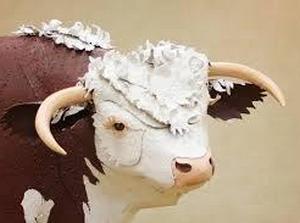![]()

As if Chadron State College Homecoming and the 11th Annual Harvest Moon Fall Festival weren’t enough for one day, Chadron Saturday night is also hosting the 9th annual Nebraska Hereford Crossroads dinner and program tonight.
It’s at the Mari Sandoz High Plains Heritage Center at Chadron State with the doors opening at 3:00 and dinner starting at 6:00.
Hereford Crossroads celebrates the history of the distinctive red cattle with white faces species often referred to as the Beef Breed Supreme.
The Sandoz Center is the perfect place for the gathering because of the Coffee Cattlemen’s Gallery in the basement of the Chicoine Atrium.
Named for one of the most recognizable cattle families in Northwest Nebraska, the Coffee Gallery traces the development of the beef business from the Texas trail herds that arrived in the 1870s through today.
Northwest Nebraska was definitely Hereford country for a big chunk of the 20th Century. The first Herefords with pedigrees were brought to the county in 1902. It was often said in the 1930s, ‘40s and into the 1950s that Dawes County had “more registered Hereford cattle than any other county of like-size in the world.”
At the peak, there were at least 25 registered Hereford herds in the county and about that number nearby in Box Butte, Sheridan and Sioux counties.
Linda Teahon of Chadron grew up on a Hereford ranch and helped organize the Crossroads celebrations as well as a museum in Dunning that honors some of the state’s top producers and related activities.
She says Chadron was the hub of much of the activity because each November it hosted the Chadron Hereford Show, which became perhaps the community’s most popular annual event. It will be inducted tonight into the Hereford Heritage Hall of Fame
. The Chadron Hereford Show originated in 1930 and lasted through 1954, just a year shy of its Silver Anniversary. It became Nebraska’s most prominent Hereford show and one of the nation’s best on a regional basis.
When the Chadron Show was going strong, Hereford producers from several hundred miles around brought their choice bulls and heifers to be displayed and judged. Breeders from deep into the Sandhills and as far away as Kansas and Colorado brought their top cattle to be judged. Some were sold at auction during the festivities.
The animals had been broken to lead, they were washed, their hair curried and combed, their horns weighted, their feet trimmed and their tails clipped and the bush fluffed. Many had been placed on Holstein nurse cows and fed a little extra corn to make them more attractive.
It wasn’t just ranchers who got involved once the cattle arrived. So did the Chadron Chamber of Commerce and many of the business leaders. The show initially took place in the pavilion at the Chadron Sales Company, but by the late 1930s, the number of exhibitors and their cattle surpassed that capacity and a tent had to be obtained.
Finally, in 1940, an 80 x166-foot tin structure was erected through the cooperative efforts of the Hereford producers, the Chadron Chamber, and Chadron businesses. It had previously been at Lakeside, where it was part of the extensive potash operation in the western Sandhills to help produce munitions during World War I.
It reportedly cost $500 just to dismantle it. “Public-spirited” truckers hauled the huge steel beams and hundreds of sheets of tin to Chadron, where the WPA reassembled it on the fairgrounds. It was the largest structure of its nature in the region and could house about 200 head of cattle.
It also became the headquarters for 4-H livestock exhibits at the Dawes County Fair until the mid-1970s, when it was finally replaced by the Vetter Building.
During the Chadron Hereford Show’s heyday, the Chadron Chamber, the Crawford and Alliance Hereford Breeders Associations, and the Nebraska and American Hereford Associations joined forces to provide several thousand dollars in prize money that was distributed to the exhibitors whose cattle won top honors.
While the initial show in 1930 drew only 38 head, the count was 83 in 2 years and by 1941 there were 196 on display. The 1950 show is believed to have the largest with 253 white-faced animals from 40 herds on display.
Chadron newspapers said the judging sometimes attracted 1,000 spectators with most years including a banquet for the exhibitors at the Blaine Hotel. The Chadron Record reported that following the 1947 show, some people felt there were “just too many animals and people” at the event for the size and scope of the facilities.
A lively calf scramble also took place at least a few times. There was also music during the early years from the Squaw Mound Band, made up of around 50 members of farm and ranch families who lived near that landmark some 15 miles east of Crawford. After that, the Chadron High School band sometimes gave a lively evening concert.
While no one herd dominated the show during its 24-year history, several gained the spotlight time and time again. In the formative years, championships included Clyde Buffington, Charlie Denton, DL Kay, Benton Marshall, Fred Neeland, Gilbert Swinbank and the Pebble Creek Ranch – all ranches within 30 miles of Chadron.
